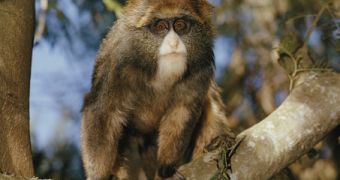Scientists were taken by surprise when they found out about the existence of a new population of De Brazza's monkeys, a threatened species in eastern Africa, in Kenya, far away from the wet forests of central Africa, good news for those hoping to save the world's primates.
A recent report signaled that habitat loss has pushed 25 species of primates to the brink of extinction. De Brazza's is not on the red list, but it's disappearing from east Africa.
The white-bearded monkey requires wet habitats and like most monkeys, it won't travel on open space more than a few kilometers, that's why its presence in Mathews Range, a tiny pocket of lush forest located 90 mi (150 km) out of the closest wet forests amazed the researchers.
"When I told people that there were De Brazza's in Mathews, they said that that was not true. I was almost doubting if it was true myself, but I had to go. The first thing is that I was shocked, because I had never seen such a large number of groups in such a small area before." said Iregi Mwenja, a researcher with Kenya's Institute for Primate Research.
Mwenja counted 200-300 De Brazza's individuals at Mathews Range, raising the number of the species in Kenya to 1,000. There are about 100,000 De Brazza's living in the dense forests of the Congo basin in central Africa, but the populations of Kenya, Uganda and Ethiopia are isolated in small pockets out of the larger groups.
A tour operator first observed De Brazza's in Mathews Range in 2004, when Mwenja, making a survey of De Brazza's in the wet mountain forests of western Kenya, encountered two times more individuals than he had previously believed.
"But the prognosis for their survival was not good in the face of burgeoning development around their habitat. The De Brazza's gray-green coloring offers excellent camouflage from predators such as leopards, eagles, pythons, and other primates, but this does not save them from the tactically superior Homo sapiens. Hundreds are killed for crop raiding and bush meat through poisoning, traps, and the use of dogs." said Mwenja.
"If the Kenyan population of the species were to survive, western groups would have to be relocated to new forests," he believed.
Mathews Range, located east off the Great Rift, has its surroundings inhabited by tribes of heavy armed cattle herders, who practiced road banditry, but exactly the ecology of the forest and the local taboos against killing wildlife protected De Brazza's.
"People in Kenya are very excited about the De Brazza's, and [the monkeys] seem to be quite rare, because they seem to be just hanging on in western Kenya. So it's great to have this discovery in Mathews Range." said Marina Cords, a biologist at Columbia University in New York who has studied De Brazza's.
The new monkeys had the same diet, physical appearance and social behavior like those from western Kenya. "These similarities suggest the De Brazza's in Mathews Range are quite closely related to their cousins west of the Great Rift Valley. The groups must have been part of the same population long after the valley opened up some two million years ago, dividing Kenya's eastern savannas from the forested hills of the west. If the group in Mathews had been isolated several hundred thousand years ago, they would be quite different," said Richard Leakey, a leading conservationist and former head of the Kenya Wildlife Service.
"Today the Rift Valley is arid. Trees are sparse. But not so long ago, De Brazza's must have lived there. For the De Brazza's to appear as far east-150 kilometers across the Rift Valley-it implies that there was some fairly continuous natural habitat or swampy ground across the Rift Valley until relatively recently. This complete disappearance of that forest belt must be in the last 8,000 years. That relatively rapid disappearance of forest suggests that climate change is affecting the world's habitats faster than we think." said Leakey.
But De Brazza's monkeys inhabiting East Africa are different from those living in the Congo basin.
"They have a totally different social system than the ones in western Africa," said Joseph Muriuki Wahome, a zoologist at Mississippi Valley State University in Itta Bena, Mississippi, who has studied De Brazza's in western Kenya.
"In Gabon they found fairly small monogamous troops. But the ones in Kenya live in pretty large groups, and they were all made up of single males who were polygamous. If it's only in East Africa that the population has become extremely small and very isolated, [the newfound population] is still very important. Because you know what that kind of isolation means for inbreeding." added Wahome.

 14 DAY TRIAL //
14 DAY TRIAL //